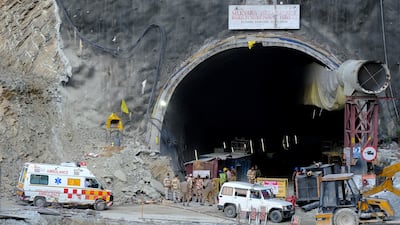The rescue operation to evacuate 41 workers trapped in a collapsed tunnel in India's Uttarakhand has entered its final leg with authorities confident they will reach the men on Thursday.
A part of the 4.5km Silkyara tunnel in the town of Uttarkashi collapsed on November 12, trapping the workers.
Authorities have since been undertaking drilling work using an auger machine to insert pipes one after the other through the rock, through which workers will then crawl out.
Nearly 60 metres of debris needs to be penetrated to insert the pipes and authorities have succeeded in drilling through 48 metres. The auger machine gets through about three metres of debris in an hour.
The rescue work was expected to be completed on Wednesday evening but the machine encountered a metal girder inside the debris, damaging the equipment and temporarily halting the operation.

“The drilling work with the auger machine has resumed and we are hoping to not face any further obstructions,” Atul Karwal, director general of National Disaster Response Force said on Thursday.
“The hills have been throwing us challenges one after the other. All the rescue teams are on standby.
“The equipment has been customised and stretchers are on standby so we can take the workers out one by one. We are inserting two pipes. One has been laid, we are welding the second pipe.”
A team of doctors and 41 ambulances are waiting outside the tunnel and once the workers are rescued, they will be taken to nearby hospitals after being examined.

The tunnel is a part of Prime Minister Narendra Modi’s ambitious Char Dham all-weather road project, to improve connectivity to four Hindu pilgrimage sites in the state.
It is being constructed to connect two of the holiest Hindu shrines of Uttarkashi and Yamunotri.
Nestled in the lap of the Himalayas, Uttarakhand is known for its natural beauty and houses dozens of major Hindu temples, receiving tourists all year round.
But the ecologically sensitive region has been facing the brunt of climate change and rampant construction.
The state has been hit by disasters, including floods in 2013 that devastated Kedarnath, one of the holiest Hindu shrines, killing more than 5,700 people. A glacial lake burst in 2021, triggering a flash flood at a hydropower project construction site that killed at least 200.
Following the incident, the National Highways Authority of India undertook a safety audit of all 29 under-construction tunnels across the country to ensure safety.


